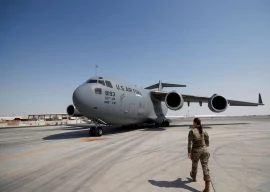
So what happened? Apparently bad weather, but not severe enough to bring down an airliner. These pilots were only trying to land through a weather system that was perhaps, at worst, only asking them to go elsewhere. Given the aircraft’s capability and experience of its pilot, it was safe enough to give it a try, remaining well within safety parameters and procedures and if that didn’t work, the plane could have been flown to another airport and return when the weather got better.
To start with, the aircraft was flying in a condition where there was precipitation-induced poor visibility and very low clouds. It had the only option, like all other approaching aircraft, to land at Runway 12 (which runs in a southeasterly direction). Ordinarily at Islamabad airport, an aircraft would approach normally – which would be to use Runway 30 (which runs in a northwesterly direction). For some days prior to the crash, unfavourable weather (high winds/poor visibility) meant that pilots were being asked to use Runway 12. Normally what is done is to use the weather-favourable runway or if that is not possible then to use Runway 30 because it has an instrument landing system (ILS). As he does this, the pilot can execute a missed approach at a height higher than that for one in the normal approach (for Runway 30). After that he begins a mix of ‘contact’ and ‘circle to land’ procedure. This would mean that after going past Runway 30, the pilot comes around and tries to land at Runway 12, all the time remaining in visual contact with the airport. If visual contact can’t be made at any point, then the aircraft is advised to fly to another airport, in this case, Peshawar, Lahore, or even Multan.
This circle-to-land procedure is safe; the flight pattern is engineered to perfection, well within five miles of the destination airport, mostly flown parallel to the runway. Yet this aircraft was not flying parallel to the runway but in an angle roughly 45 degrees from it, and not only that, it had taken a path more than seven miles in that direction. That is why it flew over I-8/3 and Blue Area towards Saidpur Village and from there, for reasons that await investigation, the pilots turned left into their destiny along with the other 150 mortals on board. Perhaps he had lost visual contact with the runway and while executing circling approach was forced into a detour, thinking he’d get the primary ILS if he turned left turn – with his reverse sensing equipment.
If the report that air traffic control warned him of the terrain close to the plane and that he acknowledged it is correct, then the only things that come to mind are either that his path was intercepted by a low cloud, or that he was too complacent in his judgment of the point at which he had to start turning the plane. Perhaps the pilot got an incorrect reading from the GPS terrain or maybe it was massive wind shear that got the better of the jet. The point is that there are so many factors and it is difficult to say anything in hindsight. But there’s no doubt that the two pilots, one an experienced airliner and the other a PAF officer, did all they could to prevent the plane from crashing.
Published in The Express Tribune, August 3rd, 2010.





























1714129906-0/Clint-Eastwood-(1)1714129906-0-270x192.webp)










COMMENTS (25)
Comments are moderated and generally will be posted if they are on-topic and not abusive.
For more information, please see our Comments FAQ